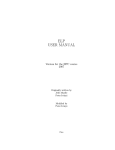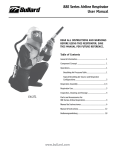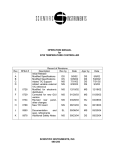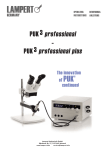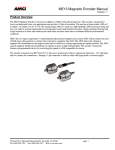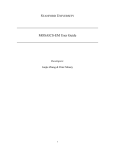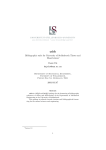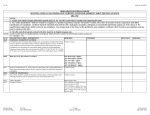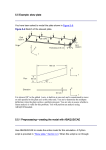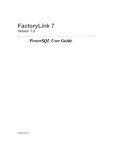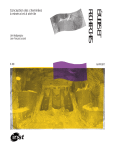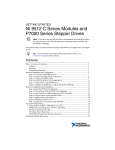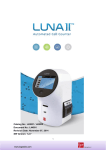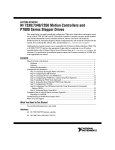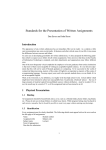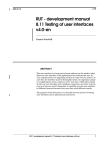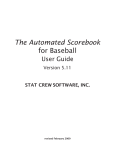Download FLAC - Itasca Denver, Inc.
Transcript
Soft Spot Itasca’s Software Newsletter In the Spotlight W ith the release of FLAC3D Version 2.0, Itasca begins offering Windows 95 and Windows NT versions of its software. Over the next 18 months, we plan to develop Windows* versions of FLAC and PFC. (See page 2 for details.) We believe that this development will not only allow us to include more user-friendly features, but it also provides the facility to add different solution schemes (including parallel processing) to improve the calculation speed. We are very excited about the potential of this new software development. We’ll keep you informed of our progress in future issues. VOLUME 5 number 1 JUNE 1997 FLAC 3D Version 2.0 is Now Available e are pleased to announce the release of the latest version of FLAC3D. Version 2.0 is provided as both a DOS application and a native Windows* application that can operate in Windows 95 or Windows NT. Users can now access the facilities available to Windows applications, such as input/output control, multitasking and graphical utilities. Save files are compatible between the DOS and Windows versions, so models can be created in the Windows version and solved in the DOS version, to take advantage of the faster calculation speed available in DOS. W Shell elements are now available as part of the expanded structural element logic in FLAC3D. Four types of structural elements are provided: beam, cable, pile and shell. Beams, cables, and piles are two-noded linear elements; shells are three-noded triangular elements. All elements interact with the FLAC3D grid at their nodes; the particular type of interaction differs depending on element type. The figure below shows a model for an advancing tunnel excavation supported by steel (cable) bolts and a shotcrete (shell) lining. (Turn to FLAC3D Version 2.0 on page 8) * WindowsTM is a trademark of Microsoft Corporation. — Roger Hart, Director of Software Services Inside Under Development . . . . 2 Modeling Hints. . . . . . . . 3 Consolidation Analysis . . . . 3 Modeling an Embedded Retaining Wall . . . . . . . . . . 4 User-defined Joint Models in UDEC . . . . . . . . . . . . . . . 6 FISH Library Update . . . 6 Questions & Answers. . . 7 Soft Notes . . . . . . . . . . . . 8 Axial stress in steel bolts and bending moments in shotcrete lining at a tunnel intersection Under Development There are three ongoing major software developments. Please contact us if you wish to receive additional information on any of these developments. FLAC++ — A native Windows 95 / NT version of FLAC is presently under development. FLAC++, written in C++, will overcome many of the restrictions of FORTRAN-based FLAC, including the following: 1. FLAC++ will have double-precision variables in all important calculation modules. This will provide more accurate solutions for problems involving small incremental changes over long time periods, such as transient groundwater and creep simulations. FLAC Version 3.4 — Several new features will be available in our next release of FLAC: • an option for high resolution graphics, • user’s manual on CD-ROM, • generalized ATTACH logic for grids of • • • • • • 2. FLAC++ will include a general x,y-grid specification as well as the existing i,j-grid specification. This will give users more flexibility in developing grids. different zone sizes, visco-plastic-brittle constitutive model, multistepping to speed dynamic analysis, incompressible fluid flow to speed transient groundwater analysis, double-precision coordinates, so that small increments are not lost in large-strain mode, direct file access from FISH, and FISH intrinsics to perform matrix operations. 3. It will be possible to define different element types for different regions of a model. For example, stiffness-matrix elements may be defined for regions in which only an elastic response is anticipated and mixed-discretization elements for regions in which plastic yielding is expected. This can potentially result in a significant saving in computer time. FLAC 3.4 is scheduled for release in the Fall of 1997. Parallel-Processing PFC — The original versions of PFC (both 2D and 3D) contained logic for splitting up a problem domain, and executing each sub-domain on a separate processor, with communication of forces and ball information between processors. We plan to extend this logic to develop a parallel version of PFC (2D and 3D) to run on two or more Pentium PCs connected by Ethernet links. This version of PFC will operate as a native Windows 95 / NT application with MPI (“Message Passing Interface”) software interface, used for communication between processors. We anticipate a significant increase in calculational efficiency with parallel processing. 4. FLAC++ will utilize the graphics interface developed for our other C++ codes, FLAC3D, PFC2D and PFC3D. This will include plotting-while-cycling so that users can view the analysis as the solution progresses. We hope to have a preliminary test-version of FLAC++ in early 1998. Parallel PFC is scheduled for release in December 1997. Shown at the Itasca International Tunneling Association exhibition in Vienna are (left to right): Heinz Konietzky, Charles Fairhurst, Lars Rosengren and Alfred Zettler. 2 Modeling Hints Consolidation Analysis In a coupled groundwater-solid analysis, it may be impractical to use the “real” value of water modulus (2x109 Pa) when the solid material is much more deformable, because the timestep will be very small. The timestep can be increased by reducing the fluid modulus, but the wrong choice can lead to an inaccurate representation of the characteristic response of the system (i.e., the consolidation time). In order to choose the lowest value of fluid modulus that yields accurate response times, we note that the coefficient of consolidation is Cv = k 1 K+4G 3 + Kn w where k is the permeability, Kw is the fluid modulus, and K and G are the bulk and shear moduli of the solid. The ratio, R, of the two terms on the bottom line determines whether Kw influences the result: R= FLAC3D 2.00 Kw n ( K + 43 G ) z-displacement x10e-2 Step 191111 Model Perspective 16:41:27 Mon Jun 2 1997 Center: X: 5.000e-001 Y: 5.000e-001 Z: 2.500e+000 Dist: 1.433e+001 Rotation: X: 20.000 Y: 0.000 Z: 20.000 Mag.: 0.8 Ang.: 22.5 -0.1 -0.2 Contour of Pore Pressure 0.0000e+000 to 2.0000e-003 2.0000e-003 to 4.0000e-003 4.0000e-003 to 6.0000e-003 6.0000e-003 to 8.0000e-003 8.0000e-003 to 1.0000e-002 1.0000e-002 to 1.2000e-002 1.2000e-002 to 1.4000e-002 1.4000e-002 to 1.6000e-002 1.6000e-002 to 1.7094e-002 Interval = 2.0e-003 History -0.3 -0.4 -0.5 3 Z-Displacement Gp 21 Linestyle -1.011e-002 <-> -1.109e-005 Vs. -0.6 1 Fluid Time 4.500e-001 <-> 1.000e+004 -0.7 -0.8 As a rule of thumb, if R = 20, then the time response is close (typically within 5%) to the response with infinite Kw. Note, however, that Kw should not be made higher than the physical value of the fluid (2x109 Pa for water). The example FLAC3D data file, given below, can be used to evaluate the influence of R. def R_factor n_w = 0.4 K_s = 44444 G_s = 33333 K_w = R_f * n_w * (K_s + 4 * G_s / 3) end set R_f = 20 R_factor config fluid gen zone brick size 1 1 5 model fl_iso prop perm 2e-7 poro n_w ini fdensity 1 ini fmod K_w model elas prop bul K_s shea G_s ini density 1.6 ini szz -400 ini pp 200 apply nstress -400 range z 4.9 5.1 fix x y fix z range z -.1 .1 ini pp 0 range z 4.9 5.1 fix pp range z 4.9 5.1 hist fltime hist gp pp 0,0,0.5 hist gp zd 0,0,6 set mech on fluid on set mech sub 200 slave set mech ratio 1e-4 solve age 1e4 ratio 1e-15 save consol.sav -0.9 -1.0 0.2 Itasca Consulting Group, Inc. Minneapolis, Minnesota USA 0.4 0.6 0.8 1.0 time x10e4 Time response of displacement and pore pressure distribution for R = 20 3 As mentioned on page 2, FLAC Version 3.4 will incorporate an option to specify fluid as incompressible, which will eliminate the need to make such approximate solutions. Modeling Hints (continued) JOB TITLE : Modeling an Embedded Retaining Wall (*10^1) FLAC (Version 3.30) Either beam elements or pile elements can be used to model an embedded retaining wall. The choice of the most appropriate structural element to use depends on the type of wall-to-soil friction and adhesion that is to be simulated. Three cases are illustrated below. First, if no slip or separation is assumed between the wall and the soil, beam elements are sufficient to represent a direct linkage between wall nodes and the grid. The following data file illustrates this case. 1.200 LEGEND 1.000 5/27/1997 08:36 step 15991 -1.833E+00 <x< 1.283E+01 -1.833E+00 <y< 1.283E+01 .800 X-displacement contours -3.00E-03 0.00E+00 .600 Contour interval= 3.00E-03 Displacement vectors Max Vector = 3.699E-03 .400 0 1E -2 Moment on Structure Max. Value # 1 (Beam ) -4.865E+04 .200 .000 grid 11 11 mo m prop dens 2000 bulk 5e9 shear 1e9 prop coh 1e4 fric 30 fix y j=1 fix x i=1 fix x i=12 ini syy -2.2e5 var 0 2.2e5 ini sxx -1.32e5 var 0 1.32e5 ini szz -0.88e5 var 0 0.88e5 set grav 10 hist unbal stru beam beg gr 5,1 end gr 5,2 seg 1 pr stru beam beg gr 5,2 end gr 5,3 seg 1 pr stru beam beg gr 5,3 end gr 5,4 seg 1 pr stru beam beg gr 5,4 end gr 5,5 seg 1 pr stru beam beg gr 5,5 end gr 5,6 seg 1 pr stru beam beg gr 5,6 end gr 5,7 seg 1 pr stru beam beg gr 5,7 end gr 5,8 seg 1 pr stru beam beg gr 5,8 end gr 5,9 seg 1 pr stru beam beg gr 5,9 end gr 5,10 seg 1 pr stru beam beg gr 5,10 end gr 5,11 seg 1 pr stru beam beg gr 5,11 end gr 5,12 seg 1 pr stru prop 10 e 2e9 a 1 i 0.08333 dens 2000 set large solve f=10 model null i 1 4 j 5 11 solve Itasca Consulting Group, Inc. Minneapolis, Minnesota USA .000 .200 .400 .600 .800 1.000 1.200 (*10^1) Figure 1. Model with beam elements essentially the same as for those using beam elements.) Compare Figure 2 to Figure 1. grid 11 11 mo m prop dens 2000 bulk 5e9 shear 1e9 coh 1e4 fric 30 fix y j=1 fix x i=1 fix x i=12 ini syy -2.2e5 var 0 2.2e5 ini sxx -1.32e5 var 0 1.32e5 ini szz -0.88e5 var 0 0.88e5 set grav 10 hist unbal struct pile begin 4.01,11 end 4.01,0 seg 11 prop 10 struct pr 10 e 2e9 a 1 i 0.08333 dens 2000 perim 1 struct pr 10 cs_sc 0 cs_sfr 30 cs_sstif 1e11 struct pr 10 cs_nc 1e4 cs_nfr 30 cs_nstif 1e11 struct node 12 fix y set large solve f=10 model null i 1 4 j 5 11 solve 10 10 10 10 10 10 10 10 10 10 10 Figure 1 shows the displacements of the soil behind the wall and the moment distribution in the wall. In the second case, pile elements are used to simulate wall friction and adhesion. The coupling-spring stiffness and strength properties at the pile nodes specify the behavior of the soil-wall interface. Note that, in this case, we do not distinguish between the two sides of the wall. The coupling springs transfer information between each structural node and the zone in which the node is located. In the example below, the strengths of the coupling springs are set to low values for comparison to the previous case. (If the strengths are set high, the results are 4 In the third case, both sides of the wall are modeled by adding an interface along one side of the pile. The interface connects grid-to-grid; it is not connected to the pile elements. In the following example, the interface represents the soil-wall interface on the left side of the wall below the dredge level. The pile coupling springs represent the soil-wall interface on the right side of the wall. The interface strength properties are set very low for comparison to the previous cases. Compare Figure 3 to Figures 1 and 2. Modeling Hints (continued) JOB TITLE : JOB TITLE : (*10^1) FLAC (Version 3.30) (*10^1) FLAC (Version 3.30) 1.200 1.200 LEGEND LEGEND 1.000 5/27/1997 08:39 step 18664 -1.833E+00 <x< 1.283E+01 -1.833E+00 <y< 1.283E+01 1.000 5/27/1997 08:46 step 37181 -1.833E+00 <x< 1.283E+01 -1.833E+00 <y< 1.283E+01 .800 .800 X-displacement contours -1.50E-02 -1.20E-02 -9.00E-03 -6.00E-03 -3.00E-03 0.00E+00 X-displacement contours -5.10E-02 -4.50E-02 -3.90E-02 -3.30E-02 -2.70E-02 -2.10E-02 -1.50E-02 -9.00E-03 -3.00E-03 .600 .400 Contour interval= 3.00E-03 Displacement vectors Max Vector = 2.005E-02 0 0 .400 .600 .800 1.000 2E -1 Moment on Structure Max. Value # 1 (Pile ) 1.374E+05 Itasca Consulting Group, Inc. Minneapolis, Minnesota USA Itasca Consulting Group, Inc. Minneapolis, Minnesota USA .200 .200 .000 .000 .000 .400 Contour interval= 3.00E-03 Displacement vectors Max Vector = 6.444E-02 .200 5E -2 Moment on Structure Max. Value # 1 (Pile ) 1.138E+05 .600 .000 1.200 .200 .400 .600 .800 1.000 1.200 (*10^1) (*10^1) Figure 3. Model with pile elements and an interface Figure 2. Model with pile elements 1993). Pile coupling-spring stiffnesses and interface stiffnesses were selected to approximate the results for the case with beam elements. grid 12 11 mo m prop dens 2000 bulk 5e9 shear 1e9 prop coh 1e4 fric 30 model null i 5 ini x add -1 i 6 13 fix y j=1 fix x i=1 fix x i=13 ini syy -2.2e5 var 0 2.2e5 ini sxx -1.32e5 var 0 1.32e5 ini szz -0.88e5 var 0 0.88e5 set grav 10 hist unbal stru pile begin 4.01,11 end 4.01,0 seg 11 prop 10 stru prop 10 e 2e9 a 1 i 0.08333 dens 2000 stru prop 10 cs_sc 0 cs_sfr 30 cs_sstif 1e11 stru prop 10 cs_nc 1e4 cs_nfr 30 cs_nstif 1e11 per 1 stru node 12 fix y inter 1 as from 5,1 to 5,12 bs from 6,1 to 6,12 inter 1 kn 1e11 ks 1e11 coh 0 tbond 0 fric 1 set large solve f 10 model null i 1 4 j 5 11 solve 3. Although the stresses are initialized in the grid, some stepping is still required to bring the model to initial equilibrium. This is because additional stiffnesses from the structural nodes contribute to the gridpoint stiffnesses when structural elements are added to a model. The additional stiffnesses produce a slight force imbalance that necessitates some stepping to equilibrate the model again. Notes: 1. Both the displacements in the grid and the magnitude of the moments in the wall increase as the wall-to-soil strengths are reduced. Also, note that the moment distribution is different for the beam-element wall (where the grid is attached) than for the pile-element wall (where the grid can slide). 2. The soil-wall properties chosen for this example are for demonstration purposes; actual values for wall friction and adhesion can be found in the literature (e.g., Clayton et al., 5 4. The examples were run in large-strain mode. Although the results are not significantly different from those for small strain, the large-strain mode is used to illustrate a consideration when using pile elements. Pile nodes must be located within zones for an interaction to be recognized. Note that the locations of the nodes in the second and third cases are shifted slightly to ensure that the nodes fall within zones. In large-strain mode, a slight adjustment of the grid during the motion calculation can cause a pile node to become prematurely detached and lead to erroneous results. This effect can also be minimized by increasing the number of nodes along the pile. — continued on Page 6 Modeling Hints (continued) 5. The interface is not attached directly to the pile elements. Although this can be done (and interfaces can be attached on both sides of beam elements), this attachment condition cannot be implemented for this situation. When zones next to an interface are deleted, the interface is redefined automatically (e.g., parts are removed), but only for interfaces that connect grid-to-grid. If the interface is attached on one side to pile or beam elements, the interface will still remain after zone deletion, and interface stresses will remain locked in. (This limitation will be removed in FLAC Version 3.4). FISH Library Update W e are in the process of collecting general-purpose FISH functions and code-specific FISH functions in order to update the FISH Library appendices in our manuals. If you have a special FISH function that you would like to share, please send it to us. We’ll be sending more information later on the FISH Library update. Reference Clayton, C.R.I., J. Milititsky and R.T. Woods. (1993) Earth Pressure and Earth-retaining Structures. London: Blackie Academic & Professional. User-defined Joint Models in UDEC User-defined joint constitutive models can be implemented in UDEC Version 3.0 by using the JOINT command and FISH access to contacts. For example, the joint strength properties in the Coulomb slip model (JOINT model area) can be set to high values, and then the normal and shear forces at contacts calculated in a user-defined FISH function from shear and normal displacements. FISHCALL can be used to ensure that the joint model is invoked at the correct point in the calculation. Please contact Itasca if you wish further information on this facility. View Title: Liquefaction of Soil Embankment Z Y X Liquefaction of a Soil Embankment Dynamic analysis with the cyclic pore-pressure generation model in FLAC3D (Plot shows pore-pressure distribution after 5 seconds of shaking. Note free-field boundary grids on the sides of the model.) 6 Software Q & A Answers to common questions submitted to Software Support. Q : Is FLAC better suited than FEM codes for plasticity analysis? A : There are many thousands of FEM programs and hundreds of different solution schemes. Therefore, it is impossible to make general statements that apply to “the Finite Element Method.” In fact, there may be so-called finite element codes that embody the same solution scheme as FLAC (full equations of motion and explicit integration). Such codes should give identical results to FLAC. FEM codes usually represent steady plastic flow by a series of static equilibrium solutions. The quality of the solution for increasing applied displacements depends on the nature of the algorithm used to return stresses to the yield surface, following an initial estimate using linear stiffness matrices. The best FEM codes will give a limit load (for a perfectly plastic material) that remains constant with increasing applied displacement. The solution provided by these codes will be similar to that of FLAC. However, FLAC’s formulation is simpler because no algorithm is necessary to bring the stress of each element to the yield surface: the plasticity equations are solved exactly in one step. Therefore, FLAC may be more robust and more efficient than some FEM codes for modeling steady plastic flow. FLAC is also robust in the sense that it can handle any constitutive model with no adjustment to the solution algorithm; many FEM codes need different solution techniques for different constitutive models. For further information, we recommend the recent publication by Frydman and Burd (1997), which compares FLAC to one FEM code and concludes that FLAC is superior in some respects for footing problems (efficiency and smoothness of the pressure distribution). Q : Why is the coefficient in Darcy’s Law expressed in terms of pressure in FLAC? Shouldn’t it be in terms of head? A: The coefficient in Darcy’s Law, expressed in terms coefficient expressed in terms of pressure will have the same value independently of the value of gravitational acceleration. Further, when coupling fluid and solid, it’s the fluid pressure that governs the physics of interaction (e.g., in order to determine effective stress and compressibility effects). The permeability coefficient used in FLAC and FLAC3D is referred to in the literature as the mobility coefficient (e.g., m2/(Pa sec) in SI units). Q: If I perform an alteration to my model that involves a change in the shear modulus, nothing happens. Why is there no effect? A : Our codes implement constitutive equations incrementally, which is necessary if the response of nonlinear, hysteretic material is to be followed. A consequence of this is that elastic moduli are taken to be tangent moduli rather than secant moduli. Increments in stress are derived from increments in strain, rather than stresses being derived from strains. A change in tangent modulus has no effect on a system in equilibrium; this is a consequence of the formulation. Section 3.5.2 of the FLAC Version 3.3 User’s Manual describes this effect and presents ways to simulate the effect of changing secant moduli, if this is what actually happens. Q : Localization and shear band propagation is typically mesh-dependent in most numerical codes. If I make a grid fine enough, can I eliminate the mesh dependency? A : If a material softens (either through real degradation of the fabric or by a reduction in the mean stress within a shear band), then the apparent softening slope will be inversely related to zone size. There is no asymptotic value of zone size for which the influence of the grid will vanish or be minimized. The only thing to do in a classical continuum formulation is to calibrate the model for a grid with a given zone size. Select the material properties and the grid size and orientation such that a test specimen (exhibiting shear bands) reproduces the required macroscopic constitutive behavior. Then, you can expect similar behavior in a simulation (of, say, a slope) that has the same zone sizes and orientations. Reference of head, is not objective (i.e., it depends on location). If you were to measure the hydraulic conductivity of the same sample on the Moon and on the Earth, you would find two different values. This is unsatisfactory. The Frydman, S. and H.J. Burd. (1997) “Numerical Studies of Bearing-Capacity Factor Nγ.” J. Geotechnical & Environmental Engineering, pp. 20–28 (January). 7 Soft Notes — FLAC3D Version 2.0, continued from Page 1 ü Beginning with FLAC Version 2.0, we are now using the Watcom C/C++ 11.0 compiler for our C++ codes. We have found that this compiler produces a substantial increase in calculational speed for FLAC3D running on a Pentium-Pro computer. FLAC3D running on a 200 Mhz Pentium-Pro is approximately 40 percent faster using the Watcom 11.0 compiler versus the Watcom 10.6 compiler. There is also a speed increase when running on a standard Pentium, although, in this case, the increase is roughly 10–15 percent. 3D The FLAC 3D 2.0 User’s Manual has been revised and expanded, and the entire manual is now available on CD-ROM. The manual can be viewed with Acrobat Reader*, and specific topics can be searched across all volumes of the manual. Several new material models have been added to Version 2.0. These are: • modified Cam-clay model, • bilinear strain-hardening/softening, ü The amount of RAM that can be accessed when running FLAC3D and PFC depends on whether the code is run under DOS or under Windows. There is a 64 MB RAM limit when running from a DOS boot. This is attributable to the limitation of the current version of the DOS/4GW DOS extender. When running in the Windows 95 or Windows NT environment, FLAC3D and PFC can access all available RAM. FLAC, UDEC and 3DEC currently do not have this limitation if running under DOS 7.0 or higher. • • • • ubiquitous-joint model, transversely isotropic elasticity model, orthotropic elasticity model, cyclic pore-pressure generation model (available with the dynamic option), and viscoplasticity model and crushed-salt model (available with the creep option). Enhancements have been made to the dynamic-analysis option. The free field boundary condition is now available. A procedure known as dynamic multistepping is now available to reduce computation time for dynamic calculations involving a wide contrast in material stiffness or zone size. ü Itasca codes directly support PostScript printers. Many word-processing programs (e.g., WordPerfect, Word) can insert our PostScript files directly. The files are used as “placeable files” — you see a grey box on your screen along with the message “PostScript Data.” As long as the bounding box data in the PostScript file are correct, the word processor will not have a problem. Several new features are available in FISH. Additional FISH variables are provided to access gridpoint, zone, interface and structural element variables. FISH functions can now access zone strains and strain rates. FISH plotting routines are available to create user-defined plot items, and user-written FISH functions can read and write files directly. Another way to use PostScript data is to “interpret” the data (i.e., decode the data into vector graphics elements and display these elements). GhostView is such an interpreter and is capable of displaying the results on a graphics screen. (GhostView is available on the Internet on anonymous ftp at ftp.cs.wisc.edu. See SoftSpot Volume 3, Number 2 for more information.) CorelDraw interprets PostScript and creates CorelDraw elements that can be manipulated. You can then output the results in a variety of formats. *Acrobat (R) Reader copyright (C) 1987-1996 Adobe Systems Incorporated. Adobe and Acrobat are trademarks of Adobe Systems Incorporated. All rights reserved. UDEC, FLAC3D, PFC2D and PFC3D can also generate PCX output, which is a bitmap specification. (This format will also be available in FLAC 3.4 and FLAC++.) Many programs (e.g., PowerPoint) can display these images on screen. These are ideal for on-screen presentations as there is no change in resolution. The files can also provide reasonable printed output. Itasca Consulting Group, Inc. 708 South Third Street, Suite 310 Minneapolis, MN 55415 USA Tel: (612) 371-4711 Fax: (612) 371-4717 E-mail: [email protected] Homepage: www.winternet.com/~icg 8








